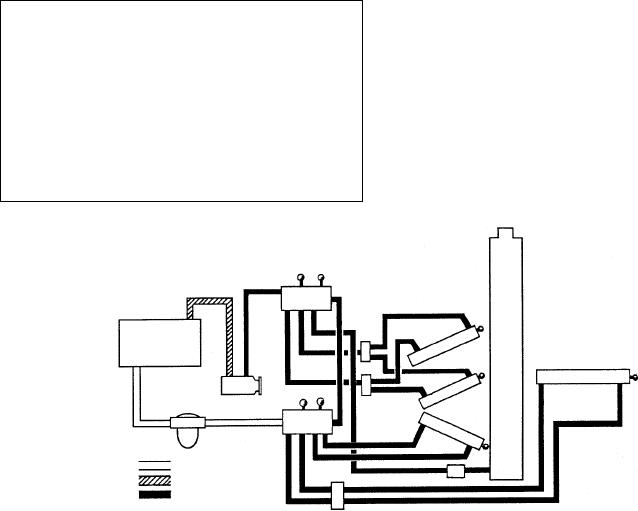
The most common forklift is the 6,000-pound
COUNTERWEIGHT
model, often called a "6K." For shipboard use, this
All forklifts have some kind of counterweight that
forklift will have a diesel engine, an automatic
transmission, rear steering, and a differential that
Some counterweights are built in as part of the frame,
operates on the same principle as any rear-steering
but most 6K forklifts have removable counterweights to
vehicle (even though this is a front-wheel drive unit).
permit access to components located behind the
Some models are driven by a bull gear system, which is
counterweights. Counterweights are very heavy,
much like a planetary gear system. That is, one small
ranging from about 4,000 pounds and up. Prior to
gear is the drive gear, and it rotates the large outer gear,
removing a counterweight, be sure to check your
which provides the torque required to transport the
technical manual to see if blocks are required to prevent
the forklift from tilting forward when the
The brakes are hydraulic and may or may not be
counterweight is removed.
powered, depending upon the model. Some models
have four-wheel brakes, but many have brakes only on
the two drive wheels. The parking brakes are controlled
by a hand lever. One other type of brake that you will
The hydraulic cylinders for the tilt and carriage
encounter on a forklift is the deadman brake (switch).
assemblies on forklifts are the double-acting type. In
There is a mechanical lever under the seat that releases
this type, fluid must be applied to either side of the
the brakes when you sit down in the drivers seat. When
piston to provide movement in the corresponding
you rise (or fall) off the seat, the spring and lever under
direction. The lift cylinder, however, is single-acting,
the seat activate the brakes to stop the forklift.
which operates similar to the cylinder assemblies of
hydraulic jacks and work stands. Fluid under pressure
is required to raise the piston in the cylinder. When this
pressure is released through a control valve, the weight
WARNING
of the fork, loaded or not, will lower the piston in the
The turning radius of a forklift is very short.
cylinder.
To achieve this short turning radius, the wheel
Figure 13-11 shows a schematic for a typical
base is short and the wheels are placed close
forklift hydraulic system. (This schematic is included
together. This gives the forklift its maneuver-
to support the explanation and does not depict any
ability, but it also makes it unstable. Always use
particular model. However, many of the features
caution and common sense when you operate a
included in this system are found in all forklift
forklift.
hydraulic systems.)
3
1
6
5
8
9
5
2
6
4
7
12
RETURN LINES
10
SUPPLY LINE
11
PRESSURE AND
WORKING LINES
ASf13011
1. Reservoir
5. Manifolds
9. Telescopic boom cylinder
2. Pump
6. Tilt cylinders
10. Orifice check valve (restrictor)
3. Control valve (lift and tilt)
7. Shift cylinder
11. Quick disconnects
4. Control valve (shift and telescopic boom)
8. Lift cylinder
12. Filter
Figure 13-11.--Schematic of a typical forklift hydraulic system.
13-17

